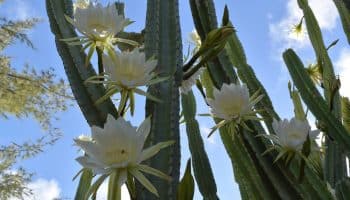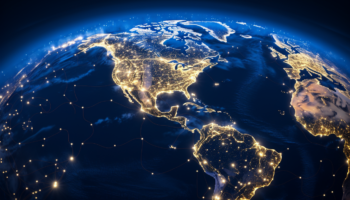The Ultimate Guide to
Mescaline
Buttons, Cactus, Mesc, Peyoto,
Mescaline is an illegal substance in some places, and we do not encourage or condone its use where it is against the law. However, we accept that illegal drug use occurs and believe that offering responsible harm reduction information is imperative for keeping people safe. For that reason, this guide is designed to ensure the safety of those who decide to use this substance.
Overview
01Though it’s not as prevalent today, mescaline was the first psychedelic to enter mainstream Western culture—before the widespread use of LSD and psilocybin. More recently, the extracted compound has shown promise in the medical and psychotherapeutic treatment of substance abuse and depression, among other conditions.
Pure mescaline is usually available as a white or brownish crystalline powder, either loose or packed into capsules as a pill. It can also be found as a liquid solution or brew. However, compared to other psychedelics, mescaline extraction tends to be rare in most parts of the world.
Beyond LSD and Psilocybin is a field. This guide will take you there.
In Third Wave’s Ultimate Guide to Safely Sourcing Psychedelics, you will discover an astonishing menu of psychedelic medicines…
…and how to source them without legal risk.
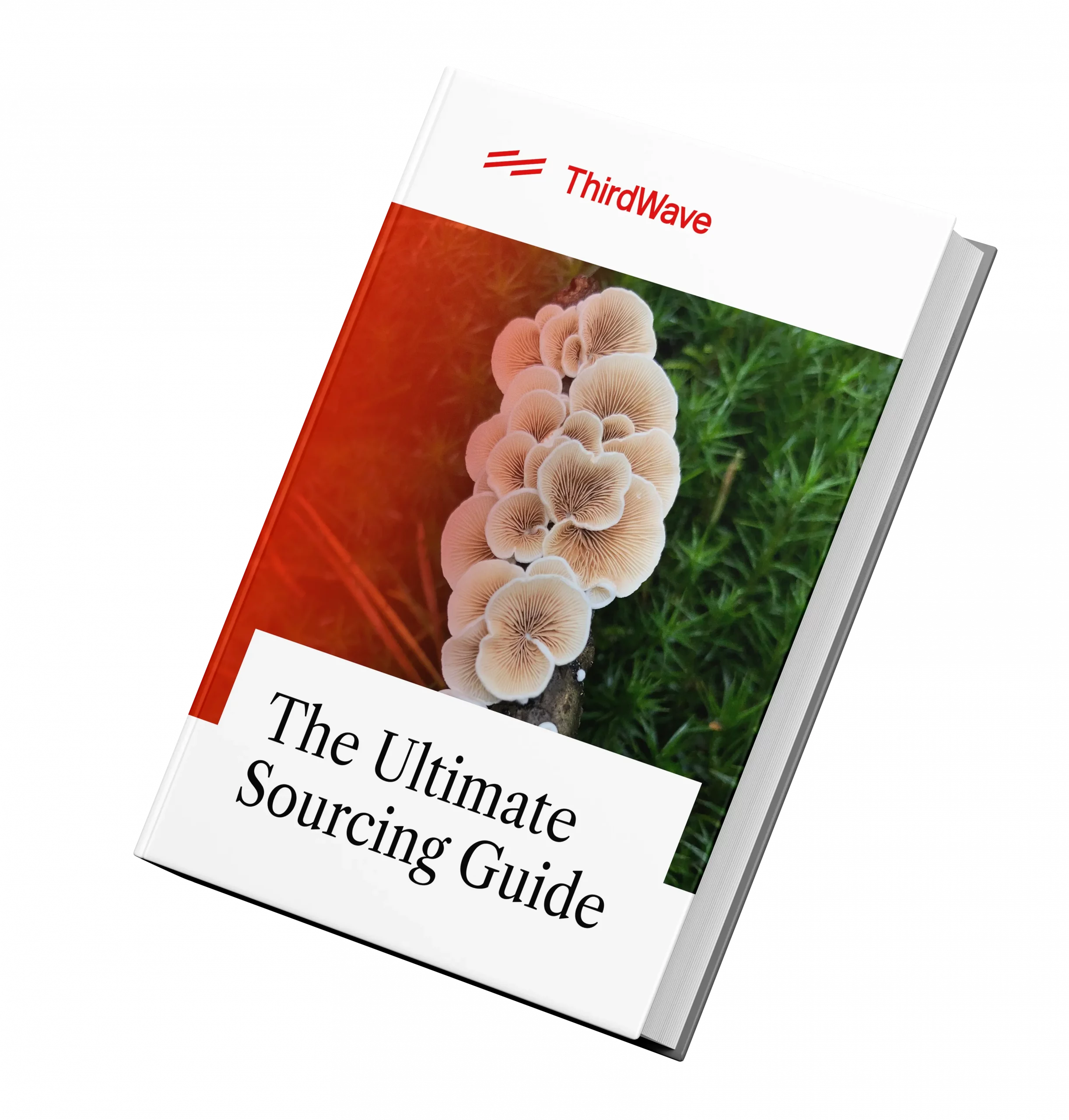
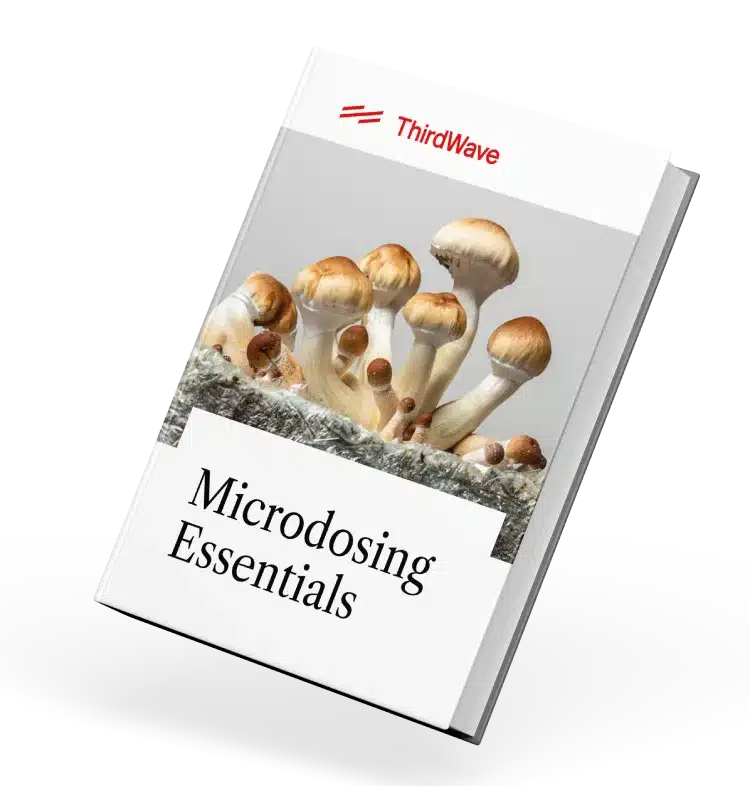
Beyond LSD and Psilocybin is a field. This guide will take you there.
In Third Wave’s Ultimate Guide to Safely Sourcing Psychedelics, you will discover an astonishing menu of psychedelic medicines…
…and how to source them without legal risk.
Experience
02What to expect
In whatever form it is consumed, a mescaline experience is highly hallucinogenic and lends itself to self-exploration. Many people report that it also creates a uniquely empathic effect in the user, making it useful for personal healing.
Mescaline effects are generally felt within 45-90 minutes of consumption, peaking at two to four hours and lasting for up to eight.[1][2] During this time, you are likely to see closed-eye visuals of colors and patterns, such as mosaics, arabesques, and spirals. These visuals often transform into more definite objects like architecture, animals, and humans. At the same time, ordinary objects in your surroundings may appear more interesting, beautiful, and amazingly mystical—qualities that define the mescaline experience.[3]
Your physical environment, as well as your own body, may distort in size and form. Some have reported the apparent loss of limbs, for instance, or the sense that hard objects like stones or walls have become soft and malleable to the touch. Other senses are also affected, sometimes to the point of synesthesia—sights may be “heard,” thoughts may be “smelled,” and sounds may be “tasted,” for example. Beautiful perfumes and music, or voices speaking strange languages, have also been reported.[3]
For many, mescaline produces an experience of depersonalization or the dissolution of the ego; everything, including oneself, feels unified.[3] This experience can give rise to clear and connected thoughts, self-realization, empathy, and euphoria, each of which can feel profound and deeply meaningful.
“Bad trips” and dysphoric symptoms are possible, but they’re likely more common for people who don’t pay attention to set and setting, or have a history of mental illness.[2]
The effects of isolated mescaline may differ from those of mescaline-containing cacti, like San Pedro, since the latter may contain a mix of other alkaloids, too. Some find extracted mescaline less nauseating, for example, and perhaps more stimulating or mentally more clear.[4][5]
Curious what it’s like to experience mescaline from San Pedro cacti? Read Third Wave’s blog about San Pedro journeys, set and settings, and recovery.
Effects
03Pharmacology
Mescaline is a substituted phenethylamine, a molecule based on the basic phenethylamine structure. Along with MDMA, 2C-B, and others, this sets it apart from the tryptamine class of psychedelics, which includes psilocybin, LSD, and DMT.
Receptor binding
Mescaline binds to virtually all serotonin receptors in the brain but has a stronger affinity for the 1A and 2A/B/C receptors. Structurally, it is similar to LSD and is often used as a benchmark hallucinogen when comparing psychedelics.
Like nearly all hallucinogens, the psychedelic effects of mescaline are likely due to its action on serotonin 2A receptors.[6]
Mescaline also tends to bind with dopamine receptors, either as a selective reuptake inhibitor or as a dopamine receptor agonist. [7]
Dosage
Mescaline dosage varies—albeit only slightly—according to how the compound is extracted. For instance, 100 mg mescaline hydrochloride (HCl) is approximately equivalent to 111 mg mescaline sulfate or 85 mg mescaline freebase.[8] These are threshold doses and are given as starting points for calculating your own dosage. A more common range for mescaline HCl is 200-300 mg. Anywhere between 300-500 mg is considered strong, while 500-700 mg is considered heavy. [1][2]
Grow 1 Year's Worth of Microdoses in Just 6 Weeks
Third Wave partnered with top mycologists to create the world’s easiest and best mushroom growing program (kit, course, and expert support).
- Pre-sterilized and sealed
(ready to use out of the box) - Step-by-step video and text course
- Access to growing expert in community
- Make your first harvest in 4-6 weeks
- Average yield is 1 - 4 ounces (28-108g)
- Fits in a drawer or closet
- Enter info for Third Wave discounts:
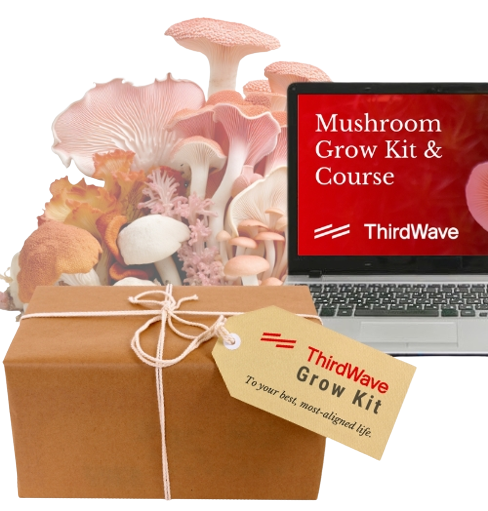
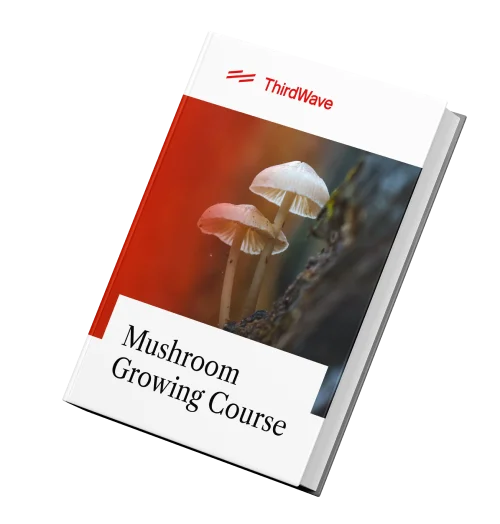
Grow 1 Year's Worth of Microdoses in Just 6 Weeks
Third Wave partnered with top mycologists to create the world’s easiest and best mushroom growing program (kit, course, and expert support).
- Pre-sterilized and sealed
(ready to use out of the box) - Step-by-step video and text course
- Access to experts in community
- Make your first harvest in 4-6 weeks
- Average yield is 1 - 4 ounces (28-108g)
- Fits in a drawer or closet
- Enter info for Third Wave discounts
Benefits & Risks
04Potential Benefits
Mescaline has long been considered a powerful agent for healing and change, making it a central component of the shamanic ceremonies of many indigenous groups in the Americas. For many, a mescaline journey offers deep insight into the self and the universe, giving one a greater sense of connection and spirituality. Mescaline is also known for fostering compassion and gratitude, while also alleviating psychological disorders such as anxiety, depression, PTSD and addiction.
Mescaline has also been shown to help people solve problems, access their creativity, be more environmentally conscious, and improve learning. In its original use, the plant medicine was also used to treat a number of ailments, including snake bites, wounds, skin conditions, and general pain.
Risks
Due to its status as an internationally controlled substance, research into the harm potential of mescaline—especially long-term—has been limited. A lethal dose has never been identified, probably because it’s too high to be taken accidentally.[9] In other words, to the best of our knowledge, nobody has ever died from a mescaline overdose.
A 2005 study into the ceremonial use of peyote among Native American populations found there to be no detrimental long-term effects.[10] It should be noted, however, that its use in other contexts may not be as safe—later studies have found an association between prior mental health problems and “bad trips.” Still, mescaline appears to present little risk of flashbacks, or hallucinogen persisting perception disorder (HPPD). [11][12]
Mescaline has been linked to memory and problem-solving impairments in rats, but only at very high doses (30 mg/kg/day).[13][14]
Peyote is traditionally consumed by Huichol women during pregnancy, but mescaline has been linked to fetal abnormalities and should be avoided by pregnant or breastfeeding women.[15][16]
It should also be avoided by anyone with a heart condition and/or high blood pressure, particularly in combination with blood pressure medications. Other drugs to avoid combining with mescaline include tramadol, immunomodulators, alcohol, and stimulants like cocaine and amphetamines. [16][17]
When taking mescaline, it’s advised that you remove hazards, including sharp objects and things you might trip over. It’s also wise to ensure easy access to drinking water, as well as a toilet or bucket in case of purging. A responsible sitter is also a good idea, at least for first-timers. Mescaline should be taken on an empty stomach to minimize nausea and maximize absorption.
Personal Growth
05In line with Native American ritual use of peyote, mescaline can also help people solve sticky problems. In one study, a group of 27 men were given mescaline and asked to think about a problem they were facing at work, some of which had persisted for months. After just one dose, almost every participant either solved the problem for themselves or came up with new ways to approach it.[22]
Peyote may also boost learning capabilities. In another study, researchers found that mescaline helped goldfish learn to avoid a shock more quickly. These findings support the prevailing view that mescaline and other psychedelics can enhance creativity. As the psychologist Stanley Krippner put it, “to invent something new, one cannot be completely conditioned or imprinted.”[23] Psychedelics like mescaline tend to dissolve preconceptions and elicit fresh perspectives on reality.
Therapeutic Use
06Research into mescaline’s psychotherapeutic potential is still limited, but renewed interest in the drug shows that it could successfully treat mental health disorders. Studies suggest, for example, that mescaline may increase blood flow and activity in the prefrontal cortex, the area of the brain in charge of planning, problem-solving, emotional regulation, and behavior. Low activity in this area is linked to depression and anxiety, leading scientists to hypothesize that mescaline could help alleviate symptoms of these disorders.
Mescaline also activates serotonin and dopamine receptors, which could help boost mood and treat depression. In fact, one of the traditional therapeutic uses for peyote was as an antidepressant, and depression scores are reportedly low among members of the Native American Church, where peyote use is common.[24]
Some researchers have found that the antidepressant benefits of mescaline correlate to a subjects’ willingness to engage with the experience, to face themselves and to act upon the insights received. In one mid-century study, some of the most significant transformations or breakthroughs came about months after the experience itself, even if the initial psychedelic therapy session seemed to be a failure. In the context of psychotherapy, mescaline may also be useful for re-living or recalling repressed memories.
Mescaline could also help reduce suicidal thoughts, according to researchers at the University of Alabama. Using data from the National Survey on Drug Use and Health, the researchers found that people who have used a psychedelic drug at least once in their life show lower rates of suicidal thinking.
A 2013 study also found that lifetime mescaline or peyote use was significantly linked to a lower rate of agoraphobia, an anxiety disorder where subjects perceive their surrounding environment to be threatening.
Addiction is another promising application for mescaline’s therapeutic potential. As peyote, mescaline has long been used in traditional ceremonial contexts to treat alcoholism. It’s interesting to note that while alcohol abuse rates among the Navajo and other Native American tribes are said to be roughly twice the U.S. average, they are significantly lower among NAC members.[25][26][24] This correlation isn’t conclusive, of course, but research does suggest that there could be a more-than-casual link. In fact, a researcher at Harvard Medical School who has spent years studying peyote use found that the substance has reduced rates of alcoholism and drug abuse among Native Americans. He also concluded that the ceremonies themselves are an important element to the plant’s healing effects.
In traditional settings, mescaline has been used for alleviating symptoms of fever, headache, sunstroke, and arthritis.[27] Actually the cactus is traditionally seen as something of a cure-all and is sometimes taken daily. According to some Native Americans, the proper use of peyote renders all other medicines superfluous.[28] While there are key differences between modern Western medicine and the medico-religious approach of Native American mystics, clinical studies have supported mescaline’s role in pain relief, and in promoting the release of growth hormones.[29][30]
Microdosing
07While psilocybin and LSD are more commonly used for microdosing, mescaline is a good alternative. In fact, many users find mescaline more consistently reliable than LSD and psilocybin—and many also report greater results in personal growth and benefit. Mescaline also has a much longer history of use—and this goes for microdosing too. The (Rarámuri) Indians, for example, have used small amounts of peyote while hunting, allowing them to stalk deer for days on end without rest. [31]
In modern times, self-experimenters around the world are reporting a much wider range of benefits, including personal insights, mood enhancement, increased empathy and creativity, lifestyle changes, and even lucid dreams.
Some people have also found mescaline microdosing useful for treating the symptoms or even the underlying causes of depression, including experiencing a sense of peace and calm without the “numbness” of conventional antidepressant medications.[4] In fact, it tends to have the opposite effect of actually sharpening the senses and enhancing mental clarity.
Beyond cognitive effects, imperceptible doses of mescaline have also been shown to act as anti-inflammatory agents. In fact, this is one of the ancient medicinal uses of this compound. A 2008 study concluded that mescaline had “extraordinarily potent” anti-inflammatory effects, and a 2018 study found that psychedelics in general help regulate inflammatory pathways, which could prove therapeutic for a number of diseases, including asthma, atherosclerosis, inflammatory bowel disease, and retinal disease.
To learn more about microdosing mescaline, read our comprehensive guide.
Legality
08Otherwise, both mescaline and peyote are strictly controlled as Schedule I substances. Other mescaline-containing cacti (and plants), such as San Pedro, are legal only for ornamental purposes.[2]
Mescaline is also illegal in the UK and Canada, as well as many European countries. However, peyote and other mescaline-containing cacti are generally legal to grow for ornamental purposes. The same is true in some Australian states, including Victoria and New South Wales, but not in Western Australia, Queensland, and the Northern Territory, where even San Pedro is illegal.[2]
You can legally harvest San Pedro cactus in most countries, much easier than you think. Learn how to grow San Pedro from home.
Get Your FREE Ultimate Guide To Microdosing for Depression.
Sometimes hope comes in micro-doses. This guide will walk you through the process and how to best use the healing potential of psychedelics in a safe, intentional way to heal depression.
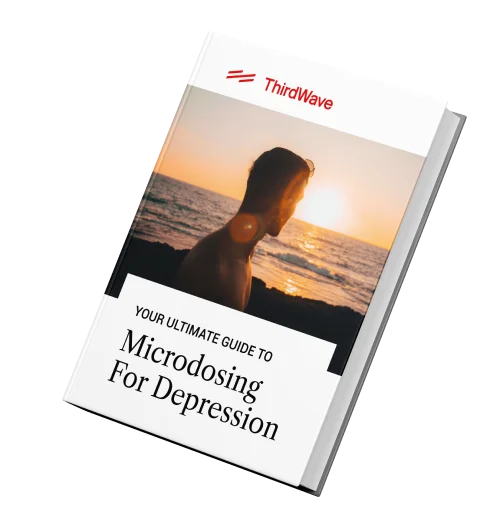

Get Your FREE Ultimate Guide To Microdosing for Depression.
Sometimes hope comes in micro-doses. This guide will walk you through the process and how to best use the healing potential of psychedelics in a safe, intentional way to heal depression.
History & Stats
09Brief history
Mescaline was the first psychedelic to come to mainstream Western attention and was the first substance that pioneering psychonaut Alexander “Sasha” Shulgin self-experimented with in the 1950s.[37] It was also one of two substances, alongside LSD, for which the term “psychedelic” was originally coined. In a letter to the author Aldous Huxley in 1956, psychiatrist Humphry Osmond introduced the term with a rhyme: “To fathom Hell or soar angelic / Just take a pinch of psychedelic.” Huxley had earlier suggested “phanerothyme,” from the Greek words for “manifest” and “spirit:” “To make this mundane world sublime / Take half a gram of phanerothyme.”[38][39]
Osmond had been investigating mescaline’s molecular similarity to adrenaline as well as its potential for treating mental illness and alcohol dependency.[39][40][41] He supplied it to Huxley in 1953, who wrote The Doors of Perception about his mescaline trip the following year.[38] In 1955, he administered mescaline to British Member of Parliament Christopher Mayhew as part of a BBC documentary. Unfortunately, while Mayhew described the effects in glowing, even mystical terms, the footage was never broadcast.[42]
Huxley’s appraisal of the drug was similarly very positive. He considered mescaline a kind of window into the world as it is, not as it is perceived by humans “obsessed with words and notions.” It was, he said, “an experience of inestimable value to everyone and especially to the intellectual.”[43]
Various governments were also interested in mescaline around the same time, but for more self-serving reasons. After discovering the Nazis were using it as a “truth serum” in concentration camps, for example, the CIA funded Project CHATTER to pick up where they left off.[40] This experiment was officially abandoned in 1953, six years after it started.[44]
In the 1960s, during his time at the Dow Chemical Company in San Francisco, psychopharmacologist Sasha Shulgin synthesized various new phenethylamine compounds from the basic mescaline molecule.[37] These included the TMAs, or trimethoxyamphetamines, which have a psychedelic stimulant effect.[45]
Peyote also became better known during the 1960s, with anthropologists documenting sacred peyote hunts with the Huichol Indians. American anthropologist and author Carlos Castaneda further popularized the cactus drug when he published his own experiences with peyote in The Teachings of Don Juan, which became a bestseller.[46] Gonzo journalist Hunter S. Thompson, another name popularly associated with the history of mescaline, wrote about his mescaline experiences in “First Visit with Mescalito” (Songs of the Doomed) and Fear and Loathing in Las Vegas.[47]
Current usage
According to the Global Drug Survey in 2014, mescaline and peyote were among the top 20 drugs used in the past month in Mexico, but nowhere else in the world. Peyote was taken by 6.4% and mescaline by 4.4% of the 643 Mexican survey respondents.[48]
Of course, we cannot generalize current usage statistics from such limited data, but it does give us some idea of its popularity relative to other substances. Unfortunately, precise usage statistics for mescaline aren’t available because surveys tend to lump it together with other substances like LSD, psilocybin, and MDMA.
That said, we can trace the popularity of mescaline over time by looking at its appearance in publications and Google searches. The number of publications related to mescaline and/or peyote peaked in the 1940s and 1950s, followed by a much larger spike in the 1960s and 1970s, during the “psychedelic revolution.” Interest spiked again in the 1990s, presumably due to the Mexican government’s 1991 listing of peyote as an endangered species and the 1994 amendments to the American Indian Religious Freedom Act.[49] Published mentions steadily decreased over the next decade or so, possibly because of the rising popularity of other psychedelics like LSD and psilocybin.
Google searches for mescaline have also decreased since 2004, although searches for peyote have remained relatively consistent.
Myths
10“Mescaline is available in microdots, like LSD”
Genuine mescaline is rare enough on the street as it is, but it’s especially unlikely to ever be found in microdot form (tiny 2.3 mm 1.5 mm pills). This is because microdots are simply too small to hold the normal active dose of mescaline as well as the fillers and binders necessary to hold them together as pills. A 400 mg dose of mescaline typically fits into a larger, fully packed capsule without any fillers. So if you’ve been sold a “mescaline microdot,” it’s probably LSD.[50][51]
“Mescal beans contain mescaline”
Although psychoactive, the “mescal beans” of Sophora secundiflora (Texas Mountain Laurel) do not contain mescaline. Nor do mezcal tequilas made from the agave plant. The fact is, the term “mescal” was erroneously applied to peyote, or “mescal buttons,” in the first place; the word actually derives from the Nahuatl (Aztec) word mexcalli, meaning “agave.”[52]
FAQ
11What is mescaline?
Mescaline is a naturally occurring alkaloid with psychedelic properties. Some native tribes of the Americas have used naturally occurring mescaline in spiritual and religious ceremonies for thousands of years.
Where does mescaline come from?
Mescaline is found in several cacti native to the Americas including: Peyote, San Pedro Cactus, and the Peruvian Torch Cactus. It can also be found in certain species of Acacia trees.
What does mescaline look like?
In the wild, mescaline is contained in certain cacti. The Peyote cactus is a small, bulbous cactus that does not have spines. It grows in clusters that are often referred to as “buttons.” The San Pedro and Peruvian Torch are columnar cacti. Their ribs are thin, yet grow tall and are often found in bunches. Other than the naturally occurring state of these cacti, you can also find mescaline in a crystalline powder form after a cactus has gone through a mescaline extraction process. The powder can range in color from white to brown based on variables in the mescaline extraction method and the presence of other naturally occurring alkaloids.
Can mescaline be detected in a drug test?
Mescaline can be detected in the urine for one to four days after use, but it’s not included in either standard or extended drug screens.[53] Virtually all labs require a specific test for the substance, so unless your employer is a real stickler and specifically worried that you’ve been frequenting peyote ceremonies, you should be fine.
Can I test my mescaline to see if it’s safe to take?
Testing your mescaline is always good practice even when you trust your supplier. Reagent test kits from Bunk Police can identify hundreds of adulterants and substitutes—offering peace of mind and potentially saving your life.
25I-NBOMe is an especially risky substance to watch out for with mescaline. The Marquis, Mecke, and Froehde reagents can help to rule it out. Simply place a tiny amount of mescaline into a sterile test tube or onto a sterile white ceramic surface and add a few drops of the reagent. Then check the color change (or lack thereof) against the supplied spectrum booklet.
Can mescaline cause psychological trauma?
If you follow the 6Ss of psychedelic use and avoid taking mescaline if you have a personal or family history of mental health issues, there appears to be very little chance of long-term psychiatric difficulties.
Of course, mescaline can make you feel crazy in the short term (acute psychosis), especially if you don’t follow the 6Ss. This is colloquially known as a “bad trip.”
Are there risks?
While mescaline by itself does not appear to have led directly to any fatalities, there are some potentially significant health risks to be aware of. It should be avoided if you have a history of mental illness, heart conditions, or high blood pressure, as well as by pregnant or breastfeeding women because of the risk of birth defects. For more information on taking peyote safely, see Precautions and Safety and toxicity.
How do I take it?
The most popular way to take mescaline is to weigh out your dose and pack it into capsules, then swallow on an empty stomach.
You could also dissolve the powder in bitter fruit juice, such as grapefruit, to mask the taste.[54]
How do I prepare mescaline from San Pedro cacti?
You can ingest San Pedro in various different ways including the raw plant itself. But we wouldn’t recommend it. San Pedro, while beautiful, isn’t known for its delicious taste. The psychedelic cactus can also be very harsh on your stomach. Learn how to prepare San Pedro tea for a smoother flavor and experience instead.
Is it legal to grow mescaline-containing cacti at home?
See Legality section for details. In general, even where it’s legal to grow San Pedro, peyote, and other mescaline-containing plants, it is illegal to consume them and especially to extract the mescaline.
Also keep in mind that peyote has become severely endangered as a natural source of mescaline, so you might want to either avoid plants harvested from the wild or grow an alternative cactus. For reference, San Pedro contains approximately 0.3-2% mescaline (compared to peyote’s 3-6%) and Peruvian torch is thought to have a mescaline content of up to 0.8%.[55][1][56]
Are you curious about cultivating San Pedro cactus from home? With care, attention, and a little bit of Third Wave research, you’ll be ready to get growing.
Can I microdose with mescaline?
Yes! For details, check out our Essential Guide to Microdosing Mescaline.
Will it produce tolerance?
Tolerance to mescaline builds up almost immediately and takes roughly seven days of abstinence to return to baseline. There is also a cross-tolerance effect with LSD and other psychedelics. This means they will have diminished effects for up to seven days after your consumption of mescaline, and vice versa.[2]
Generally, mescaline isn’t habit-forming. Many actually find their desire to use it diminishes with use.
Can I mix it with other drugs?
See the Risks section and Tripsit’s chart for details on which drugs to avoid. It’s probably best to err on the side of caution and avoid combining mescaline with any other drug, at least for the first time you take it.
That said, it appears to be relatively low risk or even positively synergistic with LSD, psilocybin, DMT, and ketamine, among other substances.
Footnotes
12[1] Erowid. (2015, Feb 21). Mescaline Dosage. Retrieved from https://erowid.org/chemicals/mescaline/mescaline_dose.shtml.
[2] PsychonautWiki. (2018, Feb 21). Mescaline. Retrieved from https://psychonautwiki.org/wiki/Mescaline.
[3] Smythies, J.R. (1953). The Mescaline Phenomena. The British Journal for the Philosophy of Science, 3(12):339-347. https://doi.org/10.1093/bjps/III.12.339.
[4] occollegeboi. (2011, Sep 14). Peyote vs. mescaline [Online forum thread]. Thread posted to https://www.shroomery.org/forums/showflat.php/Number/15078916.
[5] Benzine. (2010, Jan 5). Peyote and its differences to Pure Mescaline [Online forum thread]. Thread posted to https://www.shroomery.org/forums/showflat.php/Number/11770460.
[6] Kovacic, P., Somanathan, R. (2009). Novel, unifying mechanism for mescaline in the central nervous system. Oxidative Medicine and Cellular Longevity, 2(4):181-190. https://doi.org/10.4161/oxim.2.4.9380.
[7] Ferri, S., Arrigo Reina, R., Spadaro, C., Braga, P. (1977). 6-Hydroxydopamine Inhibits Some Effects of Mescaline Centrally Administered to Rabbits. Psychopharmacology, 55:147-149. Retrieved from https://link.springer.com/article/10.1007/BF01457850
[8] Bo. (2015, Feb 10). Calculating Mescaline Dosages. Retrieved https://erowid.org/chemicals/mescaline/mescaline_chemistry1.shtml.
[9] Asl Erowid. (2001, Mar 8). Can mescaline kill? Retrieved from https://erowid.org/ask/ask.php?ID=1778.
[10] Halpern, J.H., Sherwood, A.R., Hudson, J.I., Yurgelun-Todd, D., Pope, H.G. Jr. (2005). Psychological and cognitive effects of long-term peyote use among Native Americans. Biological Psychiatry, 58(8):624-31. https://doi.org/10.1016/j.biopsych.2005.06.038.
[11] Inaba, D.S., Cohen, W.E., Holstein, M.E. (1997). Uppers, Downers, All Arounders: Physical and Mental Effects of Psychoactive Drugs. Medford, OR: CNS Productions.
[12] Halpern, J.H., Pope, H.G. Jr. (2003). Hallucinogen persisting perception disorder: What do we know after 50 years? Drug and Alcohol Dependence, 69(2):109-19. https://doi.org/10.1016/S0376-8716(02)00306-X
[13] Koupilová, M., Henrink, J., Krs, O. (1999). Influencing of spatial memory in rats by DSP-4 and mescaline. Acta Medica (Hradec Kralove), 42(2):69-72. Retrieved from https://actamedica.lfhk.cuni.cz/media/pdf/18059694.2019.145.pdf
[14] Molinengo, L., Cassone, M.C., Baroli, A., Orsetti, M. (1986). Mescaline action on “memory decay” and “problem solving” behavior in the rat. Progress in Neuro-Psychopharmacology & Biological Psychiatry, 10(6):709-15. https://doi.org/10.1016/0278-5846(86)90055-2
[15] Meyer, S. (2011, May 24). Should I Use Peyote If I Am Pregnant or Breastfeeding? Retrieved from http://nativemothering.com/2011/05/should-i-use-peyote-if-i-am-pregnant-or-breastfeeding/.
[16] Natural Standard. (2011). Peyote. Retrieved from http://www.healthprioritiesinc.com/ns/DisplayMonograph.asp?StoreID=c8ad0990cf0d44a5bac9118cf4159a55&DocID=bottomline-peyote.
[17] Therapeutic Research Faculty. (2009). PEYOTE: Uses, Side Effects, Interactions and Warnings – WebMD. Retrieved from https://www.webmd.com/vitamins-supplements/ingredientmono-473-peyote.aspx?activeingredientid=473&activeingredientname=peyote.
[18] WhoAreYou. (2012, Nov 23). Accepting Death and Utter Ecstasy: An Experience with Mescaline (exp88982). Retrieved from https://erowid.org/experiences/exp.php?ID=88982.
[19] Dire Wolf. (2004, Mar 17). Lost In a Wilderness of Pain: An Experience with Mescaline (exp31948). Retrieved from https://erowid.org/experiences/exp.php?ID=31948.
[20] entheo. (2011, Jun 10). A Seminal Spiritual Event: An Experience with Mescaline (exp91450). Retrieved from https://erowid.org/experiences/exp.php?ID=91450.
[21] Sherwood, J.N., Stolaroff, M.J., Harman, W.W. (1962). The Psychedelic Experience—A New Concept in Psychotherapy. Journal of Neuropsychiatry, 4:69-80. https://doi.org/10.1080/02791072.1968.10524522
[22] Smith, P. The Diverging Mind. Retrieved from http://volteface.me/features/the-diverging-mind/.
[23] Krippner, S. (1969). Mescaline, Psilocybin, and Creative Artists. Retrieved from http://www.psychedelic-library.org/artist.htm.
[24] Horgan, J. (2009, Jan 12). Curing Drug and Alcohol Addiction with Peyote. Retrieved from http://discovermagazine.com/2009/the-brain/peyote.
[25] Winkelman, M.J. (2015). Psychedelics as Medicines for Substance Abuse Rehabilitation: Evaluating Treatments with LSD, Peyote, Ibogaine and Ayahuasca. Current Drug Abuse Reviews, 7(2):101-16. https://doi.org/10.2174/1874473708666150107120011.
[26] Pacific Standard Staff. (2016, Oct 10). What’s behind the myth of Native American alcoholism? Retrieved from https://psmag.com/news/whats-behind-the-myth-of-native-american-alcoholism.
[27] Rätsch, C. (2005). The Encyclopedia of Psychoactive Plants: Ethnopharmacology and Its Applications. Rochester, VT: Inner Traditions/Bear.
[28] Schultes, R.E.., Hofmann, A., Rätsch, C. (2001). Plants of the Gods: Their Sacred, Healing, and Hallucinogenic Powers. Rochester, VT: Healing Arts Press.
[29] Ferri, S., Santagostino, A., Braga, P.C. (1976). Development of Tolerance to the Antinociceptive Effect of Mescaline Intraventricularly Administered to Rabbits. Psychopharmacology, 47:261-265. Retrieved from https://link.springer.com/article/10.1007/BF00427610
[30] Demisch, L., Neubauer, M. (1979). Stimulation of Human Prolactin Secretion by Mescaline. Psychopharmacology, 64:361-363. Retrieved from https://link.springer.com/article/10.1007/BF00427525
[31] Gottlieb, A. (2009). Peyote and Other Psychoactive Cacti. Berkeley, CA: Ronin Publishing.
[32] AP. (2019, Jun 5). The Latest: Oakland 2nd US city to legalize magic mushrooms. Retrieved from https://www.apnews.com/ff023dfbf4534eba8622f504d272ff00.
[33] Decriminalize Nature Oakland. Resolution. Retrieved from https://www.decriminalizenature.org/dno-resolution.
[34] Erowid. (2017, Oct 16). Mescaline Timeline. Retrieved from https://erowid.org/chemicals/mescaline/mescaline_timeline.php.
[35] El-Seedi, H.R., De Smet, P.A., Beck, O., Possnert, G., Bruhn, J.G. (2005). Prehistoric peyote use: alkaloid analysis and radiocarbon dating of archaeological specimens of Lophophora from Texas. Journal of Ethnopharmacology, 101(1-3):238-42. https://doi.org/10.1016/j.jep.2005.04.022.
[36] Stewart, O.C. (1987). Peyote Religion: A History. Norman, OK: University of Oklahoma Press.
[37] Biello, D. (2008, Mar 20). Self-Experimenters: Psychedelic Chemist Explores the Surreality of Inner Space, One Drug at a Time. Retrieved from https://www.scientificamerican.com/article/self-experimenter-chemist-explores-new-psychedelics/.
[38] Erowid. (2015, Feb 4). Erowid Character Vaults: Humphry Osmond. Retrieved from https://erowid.org/culture/characters/osmond_humphry/osmond_humphry.shtml.
[39] Tanne, J.H. (2004). Humphry Osmond. The BMJ, 328(7441):713. Retrieved from https://www.ncbi.nlm.nih.gov/pmc/articles/PMC381240/.
[40] Lee, M.A., Shlain, B. (1985). Acid Dreams: The CIA, LSD and the Sixties Rebellion. New York, NY: Grove Press.
[41] Osmond, H. (1956). Research on Schizophrenia. Retrieved from https://erowid.org/references/texts/show/4093docid3755.
[42] SOTCAA. (2005, Feb). Panorama: The Mescaline Experiment. Retrieved from http://sotcaa.org/hiddenarchive/mayhew01.html.
[43] Huxley, A. (1954). The Doors of Perception. London: Chatto & Windus.
[44] Alliance for Human Research Protection. (2015, Jan 18). 1947–1953: Navy’s Project CHATTER tested drugs for interrogation. Retrieved from http://ahrp.org/1947-1953-navys-project-chatter-tested-drugs-for-interrogation/.
[45] Erowid. (2015, Nov 15). TMA-2 (and other TMAs). Retrieved from https://erowid.org/chemicals/tma2/tma2.shtml.
[46] Castaneda, C. (1968). The Teachings of Don Juan: A Yaqui Way of Knowledge. Oakland, CA: University of California Press.
[47] Simon & Schuster. (2018). Mescalito. Retrieved from http://www.simonandschuster.com/books/Mescalito/Hunter-S-Thompson/9780743215220.
[48] Global Drug Survey GDS2014. (2014). Last 12 Month Prevalence of Top 20 Drugs. Retrieved from https://www.globaldrugsurvey.com/wp-content/uploads/2014/04/last-12-months-drug-prevalence.pdf.
[49] DeKorne, J. (2011). Psychedelic Shamanism (Updated ed.). Berkeley, CA: North Atlantic Books.
[50] Erowid, Fire. (2001). Myth Debunking: Mescaline in Microdots. Erowid Extracts, 1:10. Retrieved from https://erowid.org/chemicals/mescaline/mescaline_info2.shtml.
[51] Ask Erowid. (2002, Apr 28). Does Mescaline come in either microdots or liquid form? Retrieved from https://erowid.org/ask/ask.php?ID=2959.
[52] Ask Erowid. (2001, Nov 12). Does the “mescal bean” contain mescaline? Retrieved from https://www.erowid.org/ask/ask.php?ID=2818.
[53] Erowid. (2015, Feb 10). Mescaline – Drug Testing. Retrieved from https://erowid.org/chemicals/mescaline/mescaline_testing.shtml.
[54] disposable125. Best way to take Mescaline HCL [Online forum comment]. Message posted to https://www.reddit.com/r/Drugs/comments/3kche7/best_way_to_take_mescaline_hcl/.
[55] Erowid, Fire. (2001). A Look at the Mescaline Content of T. preuvianus and T. pachanoi. Erowid Extracts, 2:20-21. Retrieved from https://erowid.org/plants/cacti/cacti_article1.shtml.
[56] Dasgupta, A., Wahed, A. (2014). Chapter 17 – Challenges in Drugs of Abuse Testing: Magic Mushrooms, Peyote Cactus, and Designer Drugs. In Clinical Chemistry, Immunology and Laboratory Quality Control (pp. 307-316). San Diego, CA: Elsevier. https://doi.org/10.1016/B978-0-12-407821-5.00026-7.
Get Your FREE Ultimate Guide To Microdosing for Depression.
Sometimes hope comes in micro-doses. This guide will walk you through the process and how to best use the healing potential of psychedelics in a safe, intentional way to heal depression.


Get Your FREE Ultimate Guide To Microdosing for Depression.
Sometimes hope comes in micro-doses. This guide will walk you through the process and how to best use the healing potential of psychedelics in a safe, intentional way to heal depression.

